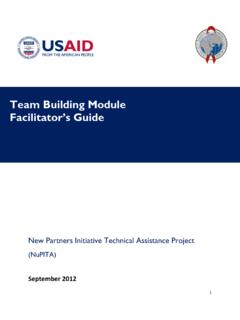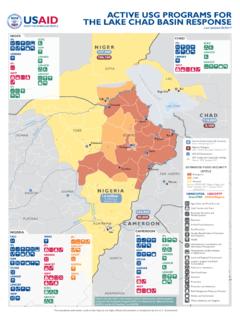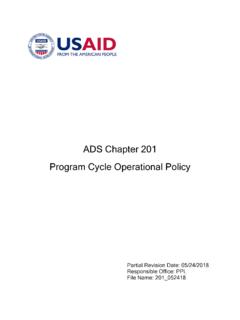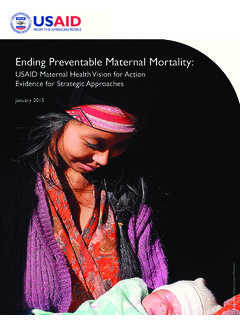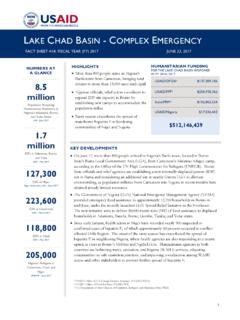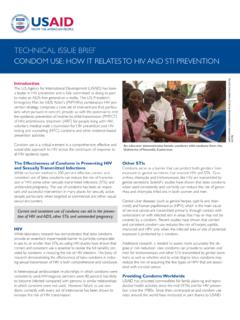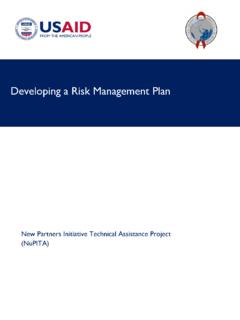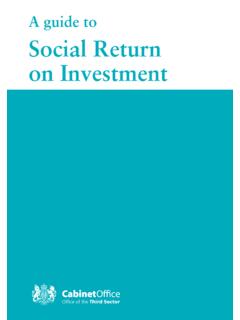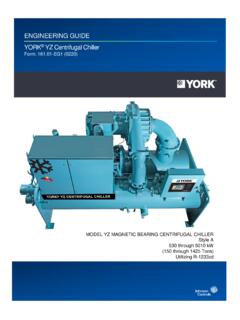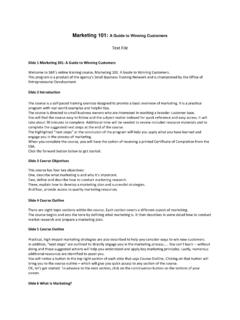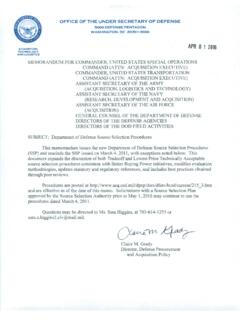Transcription of Cost Analysis Key Components Guidance and Checklist
1 cost Analysis Key Components Guidance and Checklist A Mandatory Reference for ADS Chapter 300 New Edition Date: 04/02/2013 Responsible Office: M File Name: 300mad_040213 cost Analysis KEY Components Guidance AND Checklist BUREAU FOR MANAGEMENT (M) OFFICE OF ACQUISITIONS AND ASSISTANCE TEMPLATES SERIES MAY 2012 Introduction An important part of your job as a primary member of the AO/CO Acquisition & Assistance Support Team is analyzing the proposed pricing for an award decision. Performing cost analyses is essential in order to determine that the price the Government will pay for the supply, service or program is fair and reasonable. The purpose of this topic is to provide Guidance , identify key Components of analyzing separate cost elements and profit or fee in an offeror s or contractor s proposal, as needed to determine a fair and reasonable price or to determine cost realism, and aid your ability to document the result of the Analysis through the use of the attached Checklist .
2 With only small exception concerning the provision of certified cost and pricing data for contracts, it applies to contemplated contracts and assistance awards. You should also review the following Guidance : cost Realism Analysis Key Components Guidance and Template when using this Guidance . Audience Agreement Officer Agreement Officer s Representative Contracting Officer Contracting Officer s Representative Contract Specialist Program Analyst/Activity Manager Agreement Specialist Budget Officer Acronyms A&A Acquisition & Assistance AO/CO Agreement/Contracting Officer CER cost Estimating Relationship DBA Defense Base Act FAR Federal Acquisition Regulations GAAT Government s Acquisition & Assistance Team IGCE Independent Government cost Estimate M/OAA/CAS Contract Audit and Support Division NICRA Negotiated Indirect cost Rate Agreement ODC Other Direct Costs SCA Service Contract Act TEC Technical Evaluation Committee Definitions Allocable cost : incurred solely to advance the work under the contract or agreement.
3 Allowable cost : actual or proposed expenditures that are reasonable, incurred solely to advance the work under the contract or agreement, given consistent treatment by the organization, and are within the limitations of the contract terms and statutory or regulatory requirements. cost : is a component of price. cost is a monetary measure of the expenditure for capital and labor required to complete contract performance cost Analysis : is the review and evaluation of the separate elements of cost including profit and/or fee in the Applicant/Offeror s proposal to determine if the projected price is fair and reasonable based on the Applicant/Offeror s assumptions, and whether or not the proposed cost represent what the cost of the award should be assuming reasonable economy and efficiency.
4 cost Estimating Relationships (CERs): CERs is a methodology that organizations use to develop cost estimates. CERs range from general rules of thumb, developed from practical experience to complex formulae developed from detailed statistical Analysis of past programs. An example of this type of estimating is what a construction contractor might devise relating floor space ($22- $25 per square foot) to building cost (* 2200 square feet = $49,400). Applicants may describe the use of a CER for certain elements of cost in their proposal or for the overall price of certain Components . In all cases, it is the responsibility of the Applicant/Offeror to describe any CERs used and the basis. You will then need to determine if the CER represents a fair and reasonable estimating methodology for the given cost element.
5 cost Realism Analysis : cost realism analyses shall be performed on cost -reimbursement contracts to determine the probable cost of performance for each offeror. cost realism is the process of independently reviewing and evaluating specific elements of each Applicant/Offeror s proposed cost estimate to determine whether the cost estimate is realistic for the work to be performed; reflects a clear understanding of the requirements; and is consistent with the unique methods of performance and materials described in the Applicant/Offeror s technical proposal. cost Realism Analysis is conducted by evaluating the supportive data that form the bases of the individual elements of cost to determine the probable cost of the The probable cost shall be used for purposes of evaluation to determine the best value. The probable cost is determined by adjusting each offeror s proposed cost , and fee when appropriate, to reflect any additions or reductions in cost elements to realistic levels based on the results of the cost realism Analysis .
6 See Guidance and Checklist for conducting cost Realism. Government s Acquisition & Assistance Team: Experts external to the Office of Acquisition and Assistance ( auditor, engineers, legal, transportation, programmatic, etc.) who support the AO/CO in field pricing or source selection evaluation. Independent Government cost Estimate: is the government s estimate of the resources and projected cost of the resources a contractor or a recipient will incur in the performance of an Acquisition & Assistance (A&A) instrument. These costs typically include direct costs: such as labor, supplies, equipment, or transportation; and indirect costs such as labor overhead, material overhead, general and administrative (G&A) expenses, and for contract only profit or fee. Local Compensation Plan: is each country's official system of establishing salary/compensation for Foreign Service National s (FSN), consisting of the local salary schedule, which includes salary rates, statements and authorizing benefits payments, premium pay rates, and other pertinent aspects of the FSN employee compensation (AIDAR ).
7 Negotiation Memorandum: the AO s/CO s documentation of the principle elements of the considerations leading to an award decision. Other than cost and Pricing Data (FAR Based): is data that constitutes pricing information that is not required to be certified Price: the amount of money that a buyer pays a seller for the delivery of a product or the performance of a service. Price Analysis : is the process of deciding if the asking price for a product, service or program is fair and reasonable, without examining the specific cost elements and profit the vendor used in arriving at the price. Key Roles and Responsibilities AO/CO is responsible for making a determination of fairness and reasonableness of price and documenting the basis of the determination in writing.
8 The AO/CO may request the assistance of experts from the GAAT, as required, in making the determination. Activity/Program Manager is responsible for developing the USAID s independent government cost estimate and providing support as needed to the AO/CO to determine fairness and reasonableness of price. They are also a source of expertise for source selection evaluation. Key cost Analysis Data Sources Catalog or market prices Costs or prices that can be verified through established catalog or market mechanisms are perhaps the easiest to analyze. Common examples of these types of costs include equipment ( , copiers, computers, furniture, vehicles, etc.), airfares, DHL services, etc. While salaries are generally not going to be found in a catalog, you can make comparisons of proposed salaries with salary offerings for similar services in employment sections of journals, newspapers, etc.
9 Or by comparing the position to a similar government position or by checking some of the available web sites that compare salaries ( , ). Government cost or prices Government costs or prices are often a good measure of reasonableness. For example, proposed per diem, rent for local office, allowances for government employees living overseas, salaries of foreign nationals under local country compensation plans, etc. can be compared to costs that USAID pays for same or similar services. There must be a clear showing of close correlation in the parameters for the historical and contemplated acquisition ( buys related time-wise, scope and place of performance, etc.) to be considered same or similar. Independent Government cost Estimates The use of the independent government cost estimate (IGCE) may be an influencing element for determining fair and reasonableness provided the IGCE does not merely reflect the amount of money allocated to conduct a program but a real estimate of a particular program s costs/price.
10 Key cost Analysis Considerations You must use cost Analysis to evaluate the reasonableness of cost elements when cost or pricing data are required. A cost is reasonable if, in its nature and amount, it does not exceed the cost which would be incurred by a prudent person in the conduct of competitive business. To be realistic, the costs in an offeror's proposal must be: Realistic for the work to be performed under the contract; Reflect a clear understanding of contract requirements; and Consistent with the various elements of the offeror's technical proposal. Perform price Analysis even when you perform cost Analysis . Assuring the reasonableness of individual elements of cost does not always assure overall price reasonableness. As appropriate, use the following techniques and procedures to perform cost Analysis : Verify cost or pricing data or information other than cost or pricing data.
